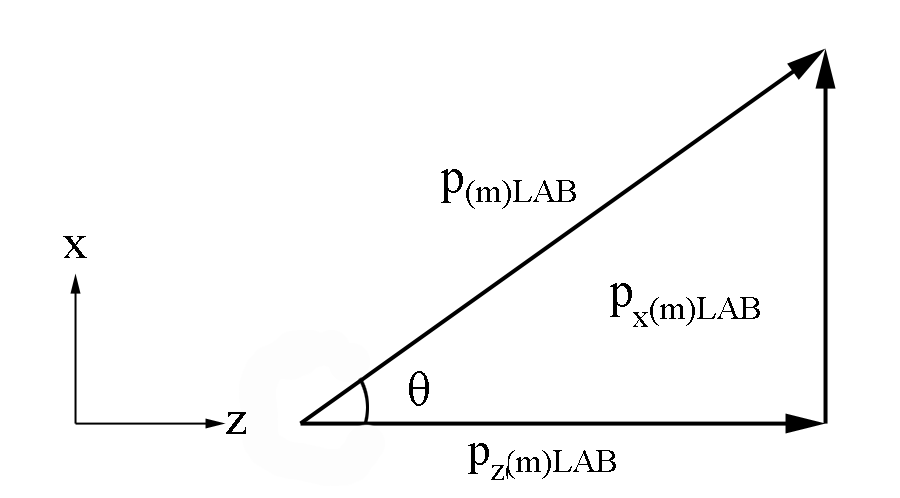Calculations of 4-momentum components
Initial Lab Frame
Assume the incoming electron has momentum of 11000 MeV in the positive z direction.
p(e−)zLab≡p(e−)Lab=11000MeV
The moller electron is initially at rest
p(m)Lab≡0
The total energy in this frame
ELab≡√p2Lab+m2Lab
ELab≡√(p(e−)Lab+p(m)Lab)2+(m(e−)Lab+m(m)Lab)2
| ⟹ELab≡√(11000MeV)2+(.511MeV+.511MeV)2≈11000MeV
|
Center of Mass Frame
Using the definition
E2≡p2c2+m2c4
⟹p2=E2c2−m2c2
We can use 4-momenta vectors, i.e. P≡(E/cpxpypz)
we can use the fact that the scalar product of a 4-momenta with itself,
P1⋅P1=E1E1−→p1⋅→p1c2=m2c4=s
is invariant
Using this, the sum of two 4-momenta forms a 4-vector as well
P1+P2=(E1+E2→p1c+→p2c)=P
The length of this four-vector is an invariant as well
P2=(P1+P2)2=(E1+E2)2−(→p1c+→p2c)2=s
P2=(P1+P2)2=(E1+E2)2−(→p1+→p2)2=s
(with c=1)
For incoming electrons moving only in the z-direction, we can write
P1+P2=(E1+E200p1z+p2z)=P
We can perform a Lorentz transformation to the Center of Mass frame, with zero total momentum
(E1CM+E2CM000)=(γCM00−βCMγCM01000010−βCMγCM00γCM).(E1Lab+E2Lab00p1zLab+p2zLab)
Without knowing the values for gamma or beta, we can use the fact that lengths of the two 4-momenta are invariant
s=P2CM=(E1CM+E2CM)2−(→p1CM+→p2CM)2
s=P2Lab=(E1Lab+E2Lab)2−(→p1Lab+→p2Lab)2
Setting these equal to each other, we can use this for the collision of two particles of mass m1 and m2. Since the total momentum is zero in the Center of Mass frame, we can express total energy in the center of mass frame as
(E1CM+E2CM)2−(→p1CM+→p2CM)2=s=(E1Lab+E2Lab)2−(→p1Lab+→p2Lab)2
(ECM)2−(→pCM)2=(E1Lab+E2Lab)2−(→p1Lab+→p2Lab)2
(ECM)2=(E1Lab+E2Lab)2−(→p1Lab+→p2Lab)2
ECM=[(E1Lab+E2Lab)2−(→p1Lab+→p2Lab)2]1/2
ECM=[E21Lab+2E1LabE2Lab+E22Lab−→p1Lab.→p2Lab−→p1Lab.→p1Lab−→p2Lab.→p1Lab−→p2Lab.→p2Lab]1/2
ECM=[(E21Lab−p21Lab)+(E22Lab−p22Lab)+2E1LabE2Lab−→p1Lab.→p2Lab−→p2Lab.→p1Lab]1/2
ECM=[(E21Lab−p21Lab)+(E22Lab−p22Lab)+2E1LabE2Lab−p1Labp2Labcos(θLab)−p2Labp1Labcos(θLab)]1/2
ECM=[m21Lab+m22Lab+2E1LabE2Lab−p1Labp2Labcos(θLab)−p2Labp1Labcos(θLab)]1/2
ECM=[m21Lab+m22Lab+2E1LabE2Lab−2p1Labp2Labcos(θLab)]1/2
ECM=[m21Lab+m22Lab+2E1LabE2Lab−2p1Labp2Labcos(θLab)]1/2
Using the relations β≡→p/E⟹→pLab=βLabELab
ECM=[m21Lab+m22Lab+2E1LabELab2(1−β1Labβ2Labcos(θLab))]1/2
where θLab is the angle between the particles in the Lab frame.
ECM=[m21+m22+2E1LabE2Lab(1−β1Labβ2Labcos(θLab))]1/2
In the frame where one particle (m2 Lab) is at rest
⟹β2Lab=0
⟹p2Lab=0
which implies,
E2Lab=[p22Lab+m22Lab]1/2=m2Lab
| ECM=(m21Lab+m22Lab+2E1Labm2Lab)1/2=(.511MeV2+.511MeV2+2(√(11000MeV)2+(.511MeV)2)(.511MeV))1/2≈106.030760886MeV
|
where E1Lab=√p21Lab+m21Lab≈11000MeV
Inspecting the Lorentz transformation to the Center of Mass frame:
(E1CM+E2CM000)=(γCM00−βCMγCM01000010−βCMγCM00γCM).(E1Lab+E2Lab00p1zLab+p2zLab)
For the case of a stationary electron, this simplifies to:
(ECMpxCMpyCMpzCM)=(γCM00−βCMγ01000010−βCMγCM00γCM).(E1Lab+m2Lab00p1zLab+0)
which gives,
⟹{ECM=γCM(E1Lab+m2Lab)−βCMγCMp1zLabpzCM=−βCMγCM(E1Lab+m2Lab)+γCMp1zLab
Solving for βCM, with pzCM=0
⟹βCMγCM(E1Lab+m2Lab)=γCMp1zLab
Similarly, solving for γCM by substituting in βCM
ECM=γCM(E1Lab+m2Lab)−p1Lab(E1Lab+m2Lab)γCMp1zLab
ECM=γCM(E1Lab+m2)2(E1Lab+m2Lab)−γCM(p1zLab)2(E1Lab+m2Lab)
Using the fact that ECM=[(E1Lab+E2Lab)2−(→p1Lab+→p2Lab)2]1/2
ECM=γCME2CM(E1Lab+m2Lab)
This gives the momenta of the particles in the center of mass to have equal magnitude, but opposite directions
Using the relation
(E1CM+E2CMp1xCM+p2xCMp1yCM+p2yCMp1zCM+p2zCM)=(γCM00−βCMγCM01000010−βCMγCM00γCM).(E1Lab+m2Lab00p1zLab+0)
⟹(E2CMp2xCMp2yCMp2zCM)=(γCM00−βCMγCM01000010−βCMγCM00γCM).(m000)
⟹{E2CM=γCM(m2lab)p2zCM=−βCMγCM(m2Lab)
⟹{E2CM=(E1Lab+m2Lab)ECM(m2)p2zCM=−p1Lab(E1Lab+m2)(E1Lab+m2Lab)ECM(m2Lab)
⟹{E2CM=(11000MeV+.511MeV)106.031MeV(.511MeV)≈53.0129177MeVp2zCM=−11000MeV106.031MeV(.511MeV)≈−53.013MeV
⟹(E1CMp1xCMp1yCMp1zCM)=(γCM00−βCMγCM01000010−βCMγCM00γCM).(E1Lab00p1zLab)
⟹{E1CM=γCM(E1Lab)−βCMγCMp1zLabp1zCM=−βCMγ(E1Lab)+γCMp1zLab
⟹{E1CM=(E1Lab+m2Lab)ECM(E1Lab)−p1zLab(E1Lab+m2)(E1Lab+m2Lab)ECMp1zLabp1zCM=−p1Lab(E1Lab+m2)(E1Lab+m2Lab)ECM(E1Lab)+(E1Lab+m2Lab)ECMp1zLab
⟹{E1CM=(11000MeV+.511MeV)106.031MeV(11000MeV)−11000MeV106.031MeV11000MeV≈53.013MeVp1zCM=−11000MeV106.031MeV(11000MeV)+(11000MeV+.511MeV)106.031MeV11000MeV≈53.013MeV
p1CM=√p21xCM+p21yCM+p21zCM⟹p1CM=p1zCM
p2CM=√p22xCM+p22yCM+p22zCM⟹p2CM=p2zCM
Moller electron Lab Frame
Finding the correct kinematic values starting from knowing the momentum of the Moller electron, ‴p(m)‴Lab , in the Lab frame,
 Using θ=arccos(pz(m)Labp(m)Lab)
Using θ=arccos(pz(m)Labp(m)Lab)
Checking on the sign resulting from the cosine function, we are limited to:
| 0∘≤θ≤60∘≡0≤θ≤1.046 Radians
|
Since,
p(m)zLabp(m)Lab=cos(θ)
⟹p(m)zLab should always be positive
 Similarly, ϕ=arccos(px(m)Labpxy(m)Lab)
Similarly, ϕ=arccos(px(m)Labpxy(m)Lab)
where pxy(m)Lab=√p2x(m)Lab+p2y(m)Lab
pxy(m)Lab=(p2x(m)Lab+p2y(m)Lab)2
and using p2(m)Lab=p2x(m)Lab+p2y(m)Lab+p2z(m)Lab
this gives p2(m)Lab=p2xy(m)Lab+p2z(m)Lab
⟹p2(m)Lab−p2z(m)Lab=p2xy(m)Lab
⟹pxy(m)Lab=√p2(m)Lab−p2z(m)Lab
which givesϕ=arccos(px(m)Lab√p2(m)Lab−p2z(m)Lab)
| ⟹px(m)Lab=√p2(m)Lab−p2z(m)Labcos(ϕ)
|
Similarly, using p2(m)Lab=p2x(m)Lab+p2y(m)Lab+p2z(m)Lab
⟹p2(m)Lab−p2x(m)Lab−p2z(m)Lab=p2y(m)Lab
| py(m)Lab=√p2(m)Lab−p2x(m)Lab−p2z(m)Lab
|
Checking on the sign from the cosine results for ϕ
| For 0≤ϕ≤−π2 Radians
|
| x=POSITIVE
|
| y=NEGATIVE
|
| For 0≤ϕ≤π2 Radians
|
| x=POSITIVE
|
| y=POSITIVE
|
| For −π2≤ϕ≤−π Radians
|
| x=NEGATIVE
|
| y=NEGATIVE
|
| For π2≤ϕ≤π Radians
|
| x=NEGATIVE
|
| y=POSITIVE
|
Moller electron Center of Mass Frame
Relativistically, the x and y components remain the same in the conversion from the Lab frame to the Center of Mass frame, since the direction of motion is only in the z direction.
| pz(m)CM=√p2(m)CM−p2x(m)CM−p2y(m)CM
|
(E1CM+E2CM)2−(→p1CM+→p2CM)2=s=(E1Lab+E2Lab)2−(→p1Lab+→p2Lab)2
where previously it was shown
(2E1CM)2=(E1Lab+m)2−(→p1Lab)2
2E21CM=E21Lab+2E1Labm+m2−p21Lab
Electron Center of Mass Frame
Relativistically, the x, y, and z components have the same magnitude, but opposite direction, in the conversion from the Moller electron's Center of Mass frame to the electron's Center of Mass frame.
where previously it was shown
Electron Lab Frame
We can perform a Lorentz transformation from the Center of Mass frame, with zero total momentum, to the Lab frame.
(E(e−)Lab+E(m)Labp(e−)zLab+p(m)zLabp(e−)zLab+p(m)zLabp(e−)zLab+p(m)zLab)=(γCM00βCMγCM01000010βCMγCM00γCM).(E(e−)CM+E(m)CMp(e−)xCM+p(m)xCMp(e−)yCM+p(m)yCMp(e−)zCM+p(m)zCM)
⟹{ELab=γLab(ECM)+βLabγLabpzCMpzLab=βLabγLab(ECM)+γLabpzCM
⟹{γLab=ELabECMβLab=pzLabELAB
Without knowing the values for gamma or beta, we can use the fact that lengths of the two 4-momenta are invariant
s=P2CM=(E(e−)CM+E(m)CM)2−(→p(e−)CM+→p(m)CM)2
s=P2Lab=(E(e−)Lab+E(m)Lab)2−(→p(e−)Lab+→p(m)Lab)2
Setting these equal to each other, we can use this for the collision of two particles of mass m1 and m2. Since the total momentum is zero in the Center of Mass frame, we can express total energy in the center of mass frame as
(E1CM+E2CM)2−(→p1CM+→p2CM)2=s=(E1Lab+E2Lab)2−(→p1Lab+→p2Lab)2
(ECM)2−(→pCM)2=(E1Lab+E2Lab)2−(→pLab)2
(ECM)2=(ELab)2−(→pLab)2
(ECM)2+(→pLab)2=(ELab)2
ELab=√(ECM)2+(→pLab)2
Since momentum is conserved, the initial momentum from the incident electron and stationary electron is still the same in the Lab frame, therefore pLab=11000MeV
ELab=√(106.031MeV)2+(11000MeV)2≈11000.511MeV
This is the same as the initial total energy in the Lab frame, which should be expected since scattering is considered to be an elastic collision.
Since,
ELab≡E(e−)Lab+E(m)Lab
Using the relation
E2≡p2+m2
| ⟹p2(e−)Lab=E2(e−)Lab−m2(e−)Lab=E2(e−)Lab−(.511MeV)2
|
Using
p2≡p2x+p2y+p2z
| ⟹p(e−)zLab=√p2(e−)Lab−p2(e−)xLab−p2(e−)Lab
|
DV_RunGroupC_Moller#Momentum distributions in the Center of Mass Frame
DV_MollerTrackRecon#Calculations_of_4-momentum_components

